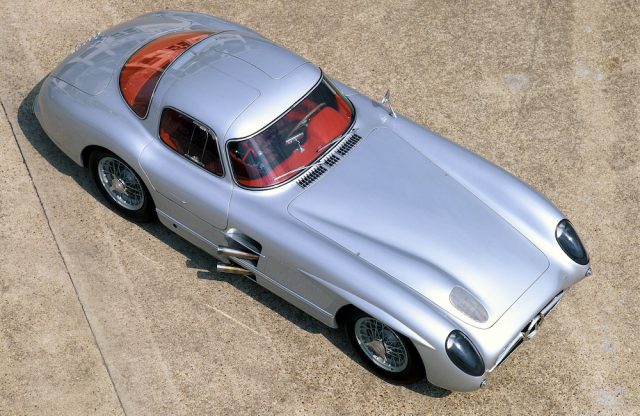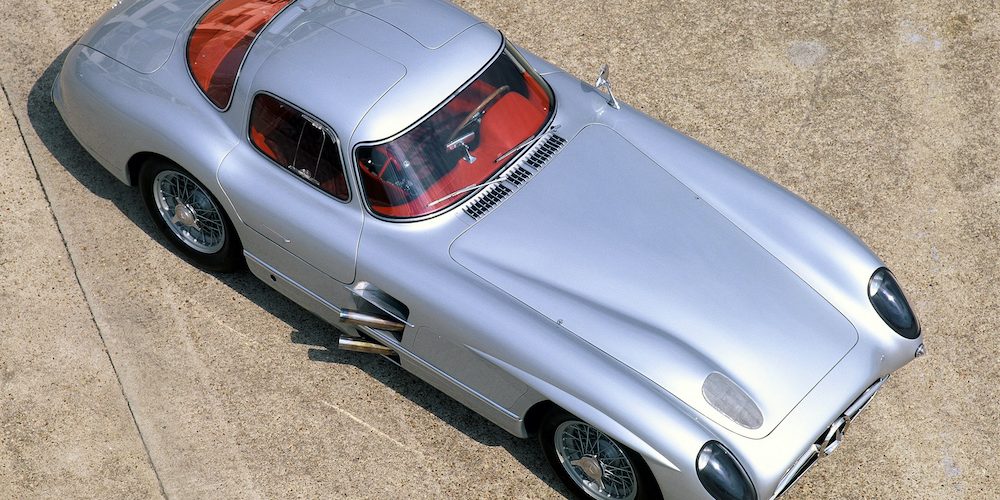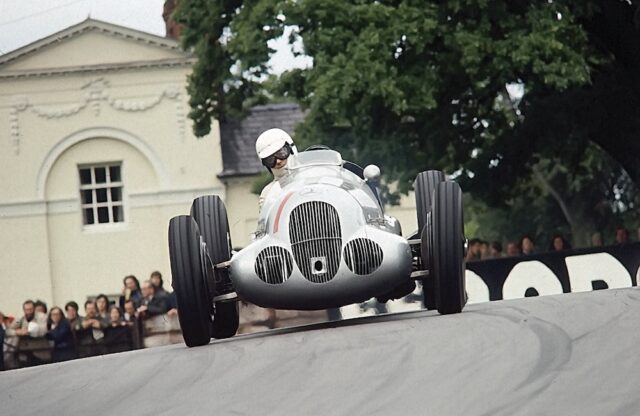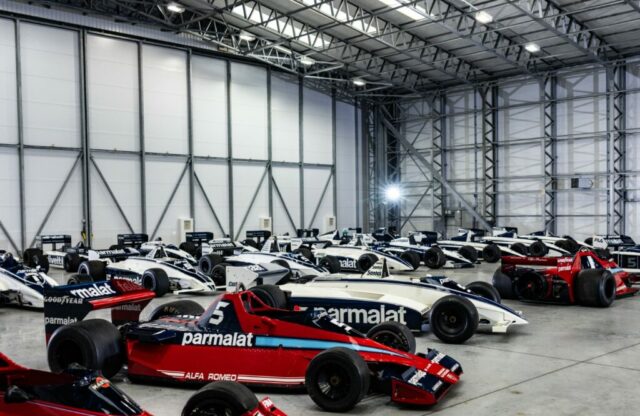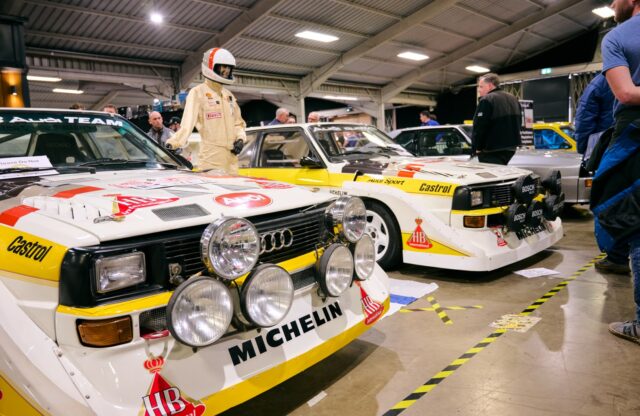Words and photographs: Karl Ludvigsen
News that one of the pair of coupé versions of the Mercedes-Benz 300SLR has reached private ownership moves us to recall their creation and significance. Once unthinkable, the sale of one of them by RM Sotheby’s via broker Simon Kidston for the highest-known price of any car has rocked the world of classic vehicles.
When Daimler-Benz returned to international motor racing in 1952, it engaged in half measures. That first season’s 300SL was ingeniously made from production-car components to get a feel for the post-war racing scene. Of this, the company’s technical chief Fritz Nallinger said: “We are just opening a little window on the motor-racing scene.” Nevertheless, the first 300SL was good enough to win Le Mans and the Mexican Road Race.
When Daimler-Benz returned to racing in earnest in 1954, it felt obliged to live up to its exalted tradition. In Grand Prix racing from 1934 to 1939 its cars were memorably successful, troubled only by the rear-engined Auto Unions. Racing heritages of both Daimler and Benz were rich with victories back to the 19th century. So when new Grand Prix rules allowing unsupercharged engines of 2.5 litres came into effect for 1954, the company led by managing director Wilhelm Haspel decided to participate.
Most companies would have seen the building and fielding of a team of Grand Prix cars a sufficiently exacting task. For Fritz Nallinger, however, sports-car racing also had a strong appeal. He well remembered 1931, when Rudy Caracciola won the Mille Miglia driving a Mercedes-Benz SSKL, the first non-Italian car and driver to triumph in the demanding classic.
Nallinger argued that with shrewd design most of the components of the Grand Prix car, the W196, could be used to make a sports-racing car, the W196-S. He envisioned both machines rolling out in the same season, with the sports-racer making its debut in the 1954 Mille Miglia. Every sinew of the works at Stuttgart-Untertürkheim was strained to achieve this goal.
As with the 300SL, engine displacement of the W196-S was 3.0 litres. It seemed a bold, even foolhardy decision to field a 3.0-litre sports-racing car against the very fast 3.5-litre D-type Jaguar – always difficult to beat at Le Mans – not to mention Ferrari’s cars of up to 4.9 litres. But it was the most that could be squeezed from an uprated version of the GP car’s fuel-injected 2.5-litre straight-eight.
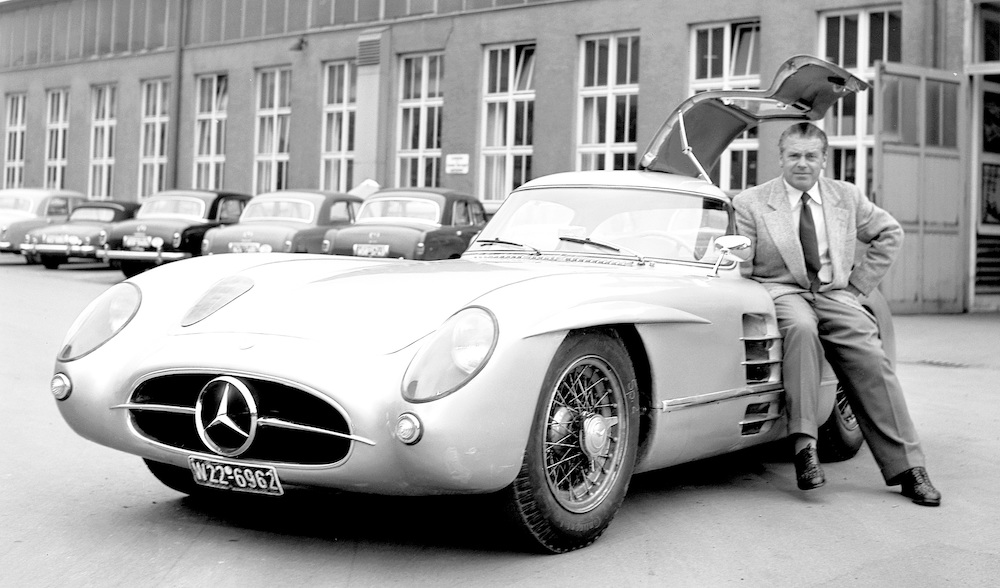
Creation of the W196-S paralleled work on the production version of the 300SL, a prototype of which made its debut in New York in February 1954. Oversight of both projects fell to Rudolf Uhlenhaut, head of the Daimler-Benz experimental department, whose vision shaped the 300SL.
Successful as head of racing engineering before the war, the half-English Uhlenhaut often tested Mercedes-Benz competition cars at speeds matching those of his professional drivers. Although Uhlenhaut did not design the cars, his was the final determination of the attributes that his company’s racing cars should have.
Common to the W196 and W196-S were fuel-injected engines with desmodromic valve trains, eliminating troublesome springs, five-speed Porsche-synchromesh transmissions mounted at the rear, torsion-bar springing with parallel wishbones in front and low-pivot swing axles at the rear, all carried by an elaborate, light and stiff multi-tubular steel space frame.
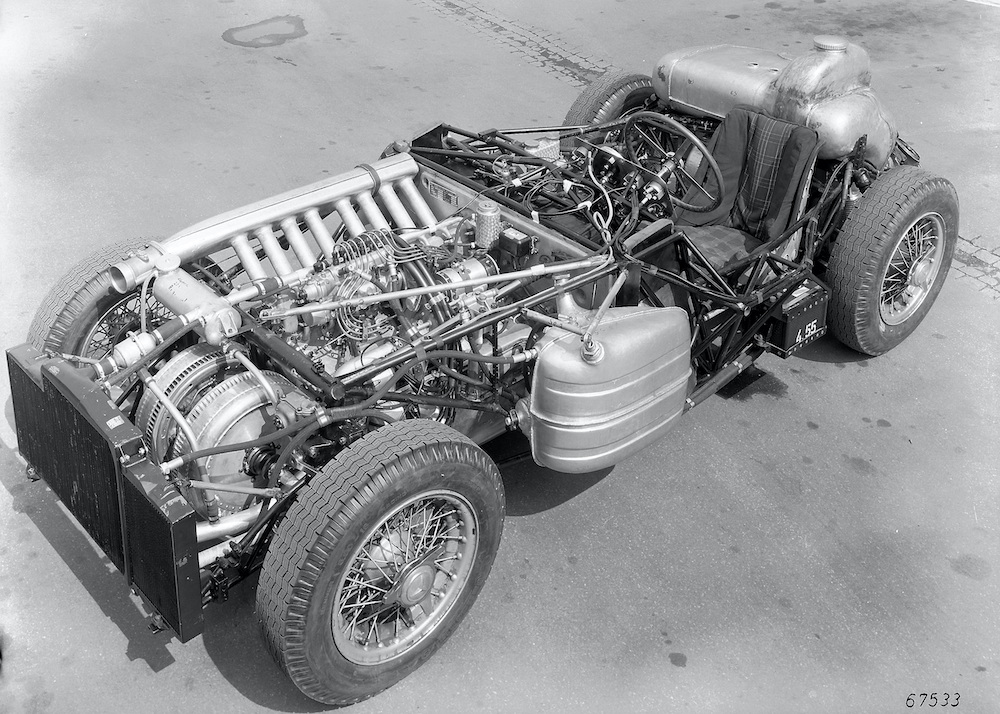
The engine sloped steeply to the right to allow a low hood line, while its drive line angled across the chassis in such a way as to require the driver to straddle the clutch and propeller shaft. Stirling Moss said that this helped him brace himself in the cockpit. At both front and rear huge turbine-cooled drum brakes were mounted inboard on the chassis.
The need to concentrate on the Grand Prix cars for 1954 meant that a prototype of the W196-S – named the 300SLR – only appeared on test late that year. Nallinger’s goal was not achieved. However they were well prepared for 1955 when they won the World Sports-Car Championship with victories in the Mille Miglia, Tourist Trophy and Targa Florio. A team driver in two of those races, John Fitch, praised the 300SLR:
“The durability of the SLR was unbelievable. As demonstrated at the Targa, it would stand up to incredible abuse and continue to operate perfectly. This highly developed sports racing machine was built like a tank, yet was as responsive as a jungle cat – a truly fabulous accomplishment in the field of automotive design.”

All the 300SLR’s successes, including wins in the Eifelrennen and Swedish Grand Prix, were achieved by cars with open cockpits. Late in the 1955 season, however, loomed the Carrera Panamericana or Mexican Road Race, which Mercedes had won in 1952 with its 300SL coupés. For this it planned to field four cars, two open 300SLRs and two closed coupé versions. One of the coupés would be driven by the team of Stirling Moss with navigator Denis Jenkinson that had triumphed with record speed in the Mille Miglia.
Unsurprisingly, for most of the 1952 300SL’s successes were achieved by coupés, one of the earliest drawings of the W196S, dating from March 1954, showed it as a coupé, which would have been ideal for the Le Mans 24 Hours. As with the 300SLR’s open versions, the coupés were styled to be in concordance with the company’s 300SL and 190SL production sports cars.
Heading body design at the Daimler-Benz Sindelfingen plant was Karl Wilfert, to whom most credit was given for Mercedes-Benz style. However, actual design work was under the direction of Walter Häcker, who had come from Horch before the war. Specialising in the sports models was Friedrich Geiger, who deserves the justified plaudits for the striking and distinctive lines of the 300SL and 300SLR.
While its cars for 1955 were being completed, Daimler-Benz brought its drivers in to get their opinions on the cockpit layout and body design. Among them were such luminaries as Juan Manual Fangio, Stirling Moss and Karl Kling. According to Denis Jenkinson, who as Moss’s racing partner had access to the works as well, the drivers expressed a preference for open cockpits. Accordingly the coupés were put on hold for the time being. The first six chassis, all of which had open bodies, were raced throughout the 1955 season.
In one 1955 race, Le Mans, a 300SLR was involved in a horrendous crash on the pit straight, scything into the packed crowd after impact with cars approaching their pits. It was the instrument of death for its driver, Frenchman Pierre Levegh, and 81 spectators in the worst disaster in the history of motor racing. The fiery crash cast a pall over the race, which continued because ending it would have clogged access points needed to deal with the wounded and dying. With his Fangio/Moss 300SLR holding a two-lap lead, racing chief Alfred Neubauer conferred with his chiefs in Stuttgart and then withdrew his team’s two remaining cars as a gesture of respect to the fallen.
This shattering catastrophe forced a major self-examination by not only racing authorities but also governments throughout the world. In its wake that season’s German, Swiss, French and Spanish Grands Prix were cancelled. Switzerland effected a permanent ban on racing on public roads. In the US the American Automobile Association withdrew from its traditional role as the sanctioning body for motor sports and record breaking.

During the forced hiatus of the abandoned races, Untertürkheim and Sindelfingen completed a coupé-bodied 300SLR on chassis 007/55, using a frame that was welded of lighter-weight tubing for the first time. It was a strikingly handsome automobile with a star in its grille and chrome strips over its side air outlets. However, for road use its lines were marred by a huge silencer attached to its exhaust stubs.
With its interior not required to provide room for luggage, its greenhouse was much more compact than that of the 300SL. No rear-quarter windows were needed, while doors were – of course – of gullwing design to leave room in the sills for the frame’s tubular structure. Instead of the 248-litre fuel capacity of most roadsters, the coupe’s tank held 172 litres.
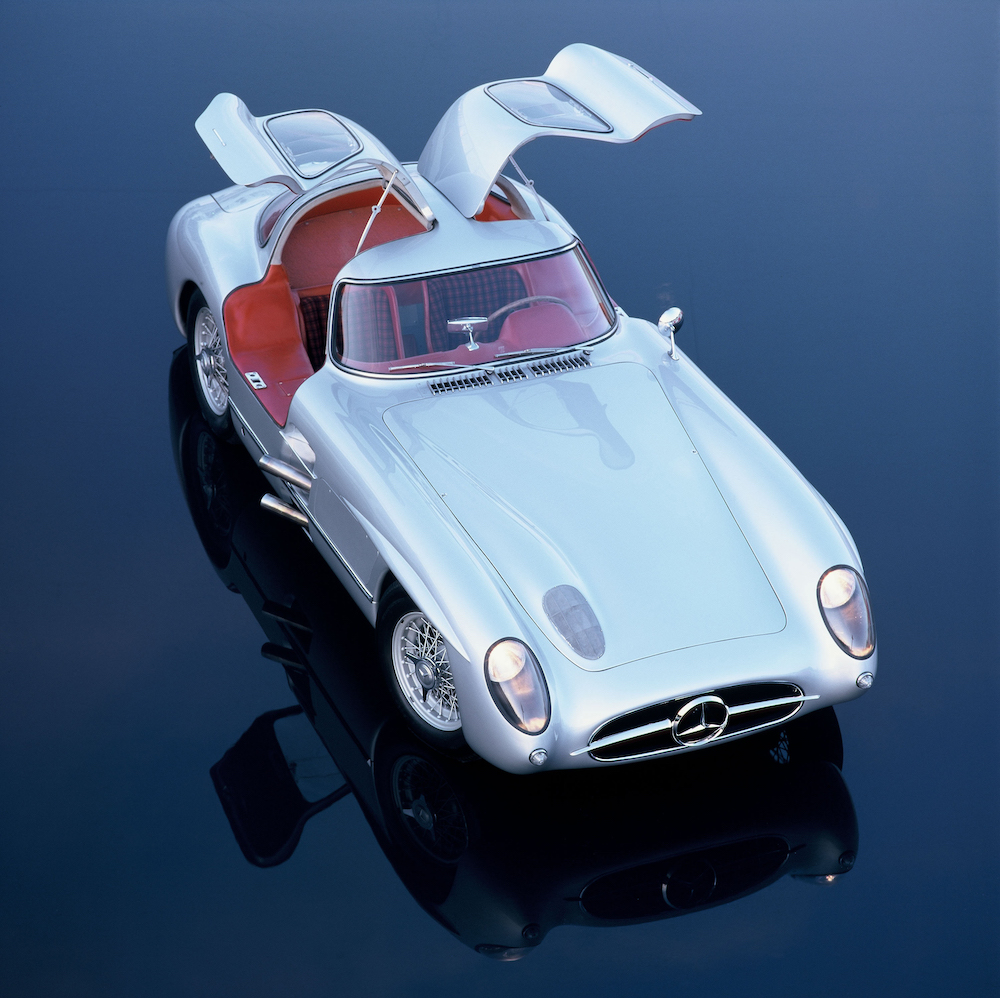
The coupé’s instrument panel was much like that of a 1953 300SL prototype, with a recessed oval at the centre of the panel encircling the minor controls. It retained the cockpit position that was common to all versions of the W196-S, with the driver’s legs spread wide on both sides of the clutch housing and a narrow footwell for the passenger. Far more lavishly than the open cars, coupé 007/55 was trimmed like a road-going 300SL in blue leather with seat facings in matching tartan cloth. Bodywork of magnesium contributed to its light dryweight of 891kg, or 1965lb.
On August 3, 1955, four days after the coupé had a brief shakedown on the experimental department’s rolling road, Rudy Uhlenhaut drove it to the Grand Prix at Sweden’s Kristanstad. Seven days later he was back, having covered 1623 miles. During practice for the Swedish race Uhlenhaut drove 122 miles on the track at racing speeds. Geared for a top speed of 165mph at 7500rpm, the brand-new 300SLR ran flawlessly throughout.
“The noise inside the coupé body was out of all proportion,” said Denis Jenkinson, who hitched a ride in Sweden with the engineer. “The mechanical thrashing that came from the engine being due to everything running on roller bearings and the central drive to the camshafts, magnetos and dynamo and injection pump being an enormous train of tiny gearwheels.” Jenkinson commented on the fantastic noise level inside the tiny cockpit. Uhlenhaut told me that it could be cured for a few pence and gave me a pair of ear plugs!”
Different final-drive gears raised all the ratios, including top gear to 189mph, for Uhlenhaut’s 681-mile return trip to Monza near the end of August. On that fast track the coupé covered 335 hard miles during tests of the sports and racing Mercedes as an overture to the Italian Grand Prix. Then the lowest gearing was fitted for practice before the Tourist Trophy in Northern Ireland, where 222 miles were covered by Fangio, Moss, Kling and Uhlenhaut while getting to know the unfamiliar and demanding road course.
The coupé’s trip to Belfast and return, a total of 2456 miles, was handled on the outbound leg by a driver new to the Mercedes-Benz team, Count Wolfgang Berghe von Trips, with the aim of helping him get accustomed to this step up from the 300SL he had been racing. “Driving a 180mph coupé across England from Dover to Liverpool was quite an experience for the young German Count,” said Denis Jenkinson, “it being fitted with an enormous silencer on the side of the body.”
Final duty for 007/55 during 1955 was as a practice car for the Targa Florio on Sicilian roads so challenging that an even lower final drive than that used in Sweden was installed. For a change the car was trucked to Sicily, where numerous drivers contributed to its total of 840 miles. Its outing ended at that distance when Moss smote a Sicilian rock with its right front corner. Damage to its suspension and frame was too heavy to be repairable with the means at hand.
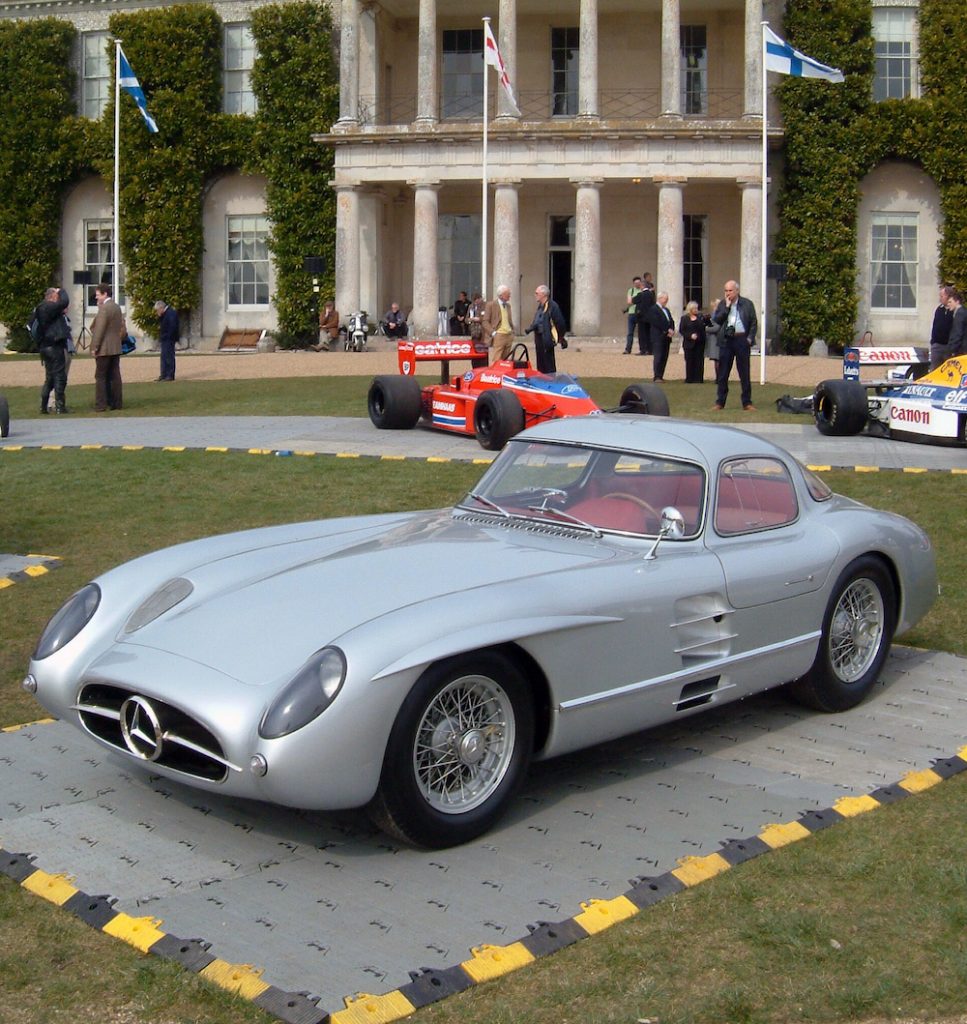
With the cancellation of 1955’s Carrera Panamericana, no immediate race duty awaited 007/55. After repairs it was thoroughly overhauled and readied for Rudy Uhlenhaut’s use at the end of December. At that time it was joined by a sister coupé on chassis 008/55, identical for all practical purposes save for a red interior that was a welcome differentiation between the two coupés.
Plans were going ahead for racing the 300SLRs in 1956, but not the Grand Prix cars. Only days after the most tragic Le Mans race in history the Daimler-Benz management board met to consider the future of the firm’s competition programme. They decided to continue in Grand Prix racing to the end of the season and thereafter to call a halt to single-seater activity. Not long afterward this decision was made public.
For the sports-racing cars, on the other hand, preparations for the 1956 season were well advanced with a new, lighter construction, using outboard front brakes and engine enhancements. The coupés were in the picture, for the racing department’s notes on the coupé that practised at the Targa Florio said: “With respect to roadholding the car is better than the open car.”
This summarised the views of the various drivers after 19 laps of the sinuous circuit with its infinite variety of turns and surfaces. Attribution of the difference was not given, although such factors as weight distribution, stiffness of the body/frame combination and aerodynamics with the coupé roof could have played a part.
On September 28 Fritz Nallinger confirmed in a note to Neubauer that the sports cars would compete in eight to ten events in 1956, and asked the team manager to let him have a list of suitable races for his review. But this was a false dawn. With the company’s post-war markets regaining momentum, the demands of racing were monopolising the research and development skills needed for improved Mercedes-Benz production cars.
On October 22 the traditional end-of-season press conference became the platform for the announcement that Daimler-Benz was withdrawing its sports cars, as well as its racing cars, from further competition “for several years” at least.

In 1956 both coupés were readied for a comprehensive road test carried out by the respected Robert Braunschweig of Switzerland’s Automobil Revue, their equipment including the big external silencer used by Uhlenhaut and von Trips in 1955. While the blue number 7 was geared for a maximum of 181mph, the red number 8 had lower 162mph gearing. Used for acceleration testing, the latter accelerated to 50mph in 5.2 seconds, 60mph in 6.8, 100mph in 13.6 and 120mph in 20.3 seconds.
Timed on the Autobahn between Munich and Ingolstadt, the blue number 7 was clocked at a two-way average maximum speed of 176.47mph. In all, Braunschweig covered 2021 miles in 007/55, accompanied by either Uhlenhaut or works mechanic Grupp. The road trials confirmed the remarkable qualities of traction, handling and braking that made the 300SLR so successful in competition.
British journalist Gordon Wilkins racked up substantial mileage in the red coupé, sometimes accompanied by Uhlenhaut’s lieutenant Walter Kostelezky – both amply supplied with ear plugs. Laurence Pomeroy Jr also had a chance to drive it at the Solitude circuit after being given a demonstration by Uhlenhaut. Late in 1956, Uhlenhaut and American racing driver Paul O’Shea covered 91 miles of Autobahn motoring at speed.
Both coupés fulfilled public relations commitments for Mercedes-Benz. Number 7 appeared in Hong Kong in non-driving condition in 1964, for example, while number 8 was used for demonstrations in 1959 and 1960, and shipped to the US in running condition in 1961, not to return home until 1963. In 1967 it was driven on the works proving ground by members of a British party and demonstrated by racing engineer Erich Waxenberger.
After being refreshed in the UK in 1986 by expert Tony Merrick, the two coupés were allotted distinctive roles. Number 7, with its blue interior, was for exhibitions and number 8, trimmed in red, for driving. Wherever they appeared, as at Goodwood in 2010, they provoked astonishment with their rakish proportions and race-bred underpinnings. They were far and away the most covetable road cars in the Daimler-Benz inventory.

In a note on September 28, 1955 Fritz Nallinger confirmed that the recently retired racing cars would not be sold. But he raised for consideration an even more intriguing idea. Taking the longer view, he suggested, the firm might consider making and selling, in one or two years, a small series of 300SLRs. The batch might amount to no more than ten or 20 cars, which would be priced very highly, he proposed, say $30,000 to $40,000. It never came to pass, but Stirling Moss’s comment applied: “Thank God it’s not for sale. I’d hate to have to run against it!”
Now we have well supported news that car number 8 has been sold for a reported €135 million (£115m, $142m) to the best candidate from a short list of ten qualified parties. Possible justification for the sale can be that this is a car completely lacking historical importance. We are told that the purchaser has the ability to maintain the car to the same standard as the builder managed. This will have limitations for one crucial reason.
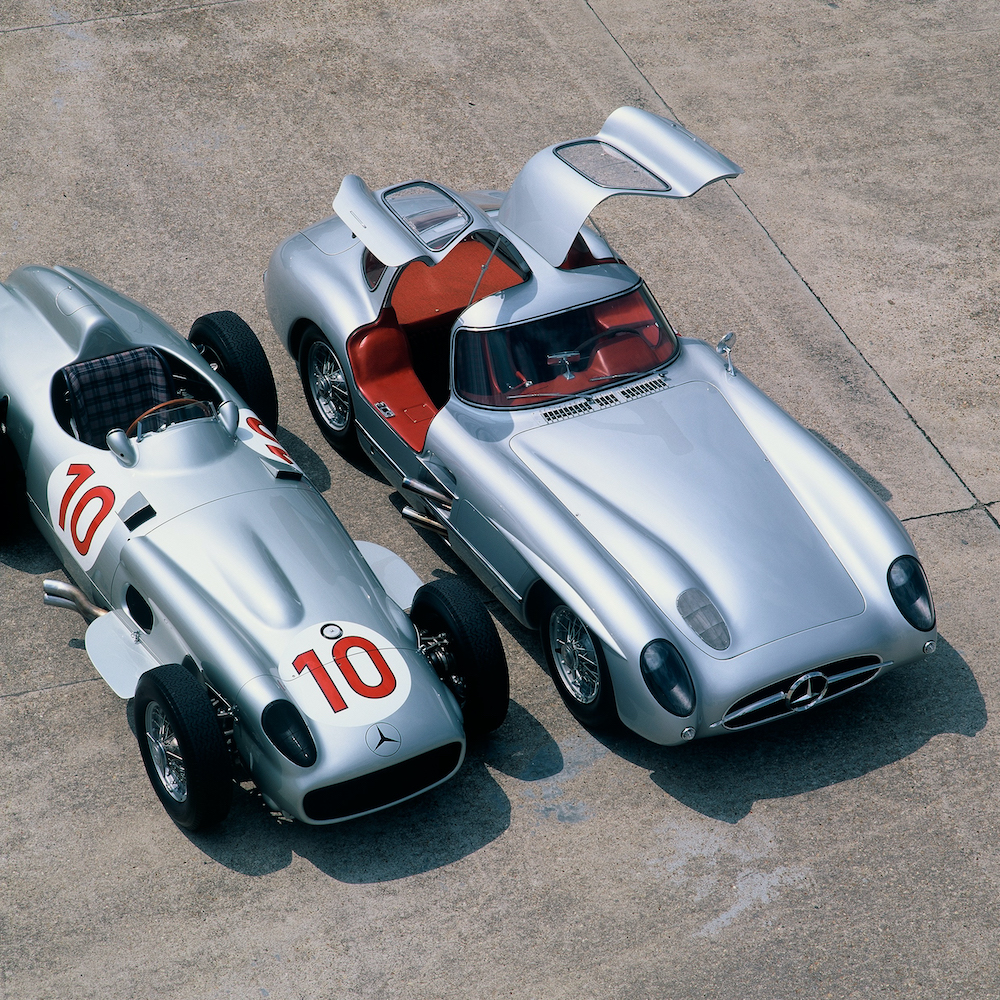
Responsibility for the M-B sports department devolved upon the aforementioned Walter Kostelezky. When he was told to clear space in the department, virtually all the considerable stock of spares for the 1954-55 campaign was scrapped. For that reason the running 2.5-litre GP cars are now powered by 3-litre SLR engines as the bulge in their hoods betrays.
Great Mercedes-Benz racing cars have been copied, the latest being the 1937 W125. But that was child’s play compared to the complexity of the engine of the 300SLR. It would be interesting to see the owner’s manual that Mercedes has provided to the buyer of the most costly car ever sold in the company’s 137-year history.
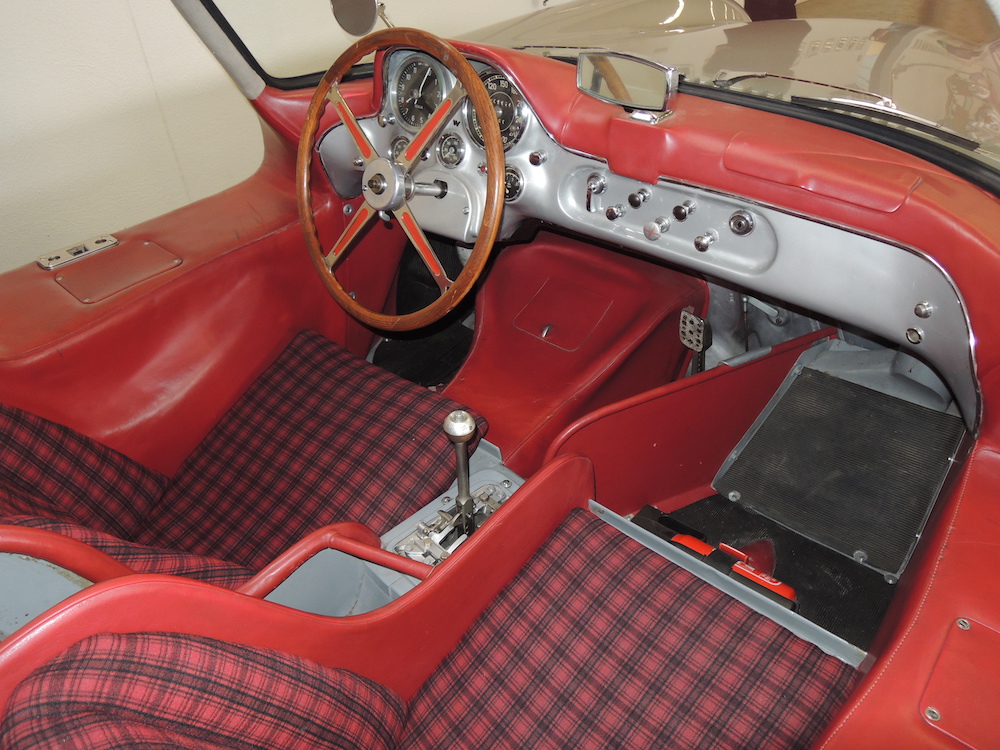
Update: It has been confirmed that the 300SLR was sold during an invitation-only event held at short notice at the Mercedes-Benz
Museum in Stuttgart on May 5, 2022. A bid of €135m from broker Simon Kidston, who says he’d been lobbying the company for 18 months to sell the car, secured the car for an unnamed collector. All monies will be used by Mercedes-Benz to set up a charitable fund for young people.

